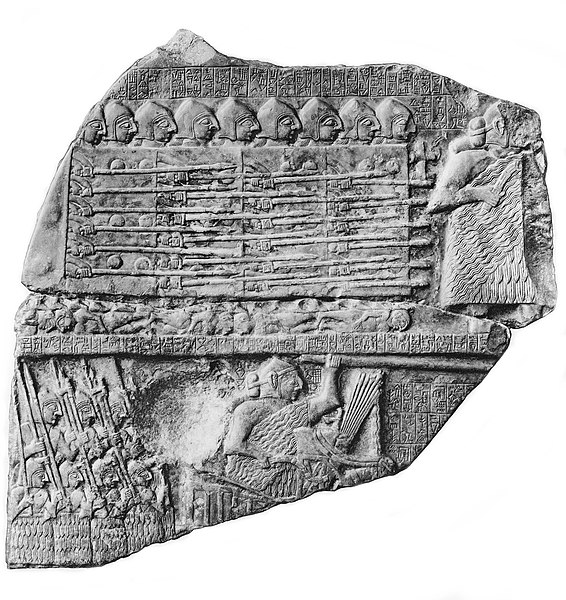The Stele of the Vultures is a monument from the Early Dynastic IIIb period in Mesopotamia celebrating a victory of the city-state of Lagash over its neighbour Umma. It shows various battle and religious scenes and is named after the vultures that can be seen in one of these scenes. The stele was originally carved out of a single slab of limestone, but only seven fragments are known to have survived up to the present day. The fragments were found at Tello in southern Iraq in the late 19th century and are now on display in the Louvre. The stele was erected as a monument to the victory of king Eannatum of Lagash over Ush, king of Umma. It is the earliest known war monument.
The stele in the Louvre Museum (front and back)
Fragment of the Stele of the Vultures.
A fragment of the Stele of the Vultures showing vultures with severed human heads in their beaks and a fragment of cuneiform script
Upper register of the "mythological" side
Lagash was an ancient city state located northwest of the junction of the Euphrates and Tigris rivers and east of Uruk, about 22 kilometres (14 mi) east of the modern town of Al-Shatrah, Iraq. Lagash was one of the oldest cities of the Ancient Near East. The ancient site of Nina is around 10 km (6.2 mi) away and marks the southern limit of the state. Nearby Girsu, about 25 km (16 mi) northwest of Lagash, was the religious center of the Lagash state. The Lagash state's main temple was the E-ninnu at Girsu, dedicated to the god Ningirsu. The Lagash state incorporated the ancient cities of Lagash, Girsu, Nina.
Relief of Ur-Nanshe. At the top he creates the foundation for a shrine, at the bottom he presides over the dedication (Louvre).
Entemena's inscribed silver vase, c. 2400 BC (Louvre)
Eannatum, King of Lagash, riding a war chariot (detail of the Stele of the Vultures). His name "Eannatum" (𒂍𒀭𒈾𒁺) is written vertically in two columns in front of his head. Louvre Museum.
The cuneiform text states that Enannatum I reminds the gods of his prolific temple achievements in Lagash. Circa 2400 BC. From Girsu, Iraq. The British Museum, London








